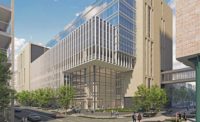Following a strong 2019, many top contractors in the region expected continued growth in 2020. Faced with the market uncertainties created by the COVID-19 pandemic, however, contractors now hope to leverage diverse portfolios of work to weather this year’s turmoil while bracing for possible market shifts on the horizon.
Last year, many of ENR Southeast’s Top Contractors reported increased revenue. For example, the top 10 firms on this year’s list tallied a combined $15.74 billion in revenue in 2019—a 19% jump from the 2018 total for those same firms. All but one of this year’s top-10 firms—DPR Construction—saw revenue increase between 2018 and 2019.
“We had our best revenue year ever [in 2019],” says Dave Priester, CEO of Choate Construction. “Everything was cooking. We had a lot of positive things in place.”
Choate reported $1.13 billion in regional revenue in 2019—up 17% from 2018. Priester notes that much of that success was the result of diversifying into more market sectors. Last year, manufacturing was its largest sector, but it only represented 14% of total revenue. He says the company made the move about four years ago to diversify more heavily as a way to buffer against a possible future economic downturn.
|
Related Link |
“In my mind, it wasn’t a matter of if, but when [the market would drop],” says Priester, whose company now serves 17 different market sectors. “In my mind, there wasn’t a better time to concentrate on broadening and diversifying our approach than when there is a lot of work.”
Now the company is banking on that broad base of work to keep it steady in 2020. “When this hit, we were luckier than most,” he says. “We had a few projects put on hold and that’s what you’d expect to happen in certain sectors, but overall our 2020 is looking good.”
Turner Construction also has a large diverse book of work continuing this year and into 2021, says Dave Robinson, Turner’s senior vice president for the Southeast. Turner closed out a very strong year in 2019 with $1.84 billion in revenue—29% above 2018. Despite the current challenges, he expects the company to stay close to plan in 2020 and possibly next year as well. “We haven’t had jobs completely go away,” he says. “Some starts have deferred, but the most we’ve slipped is six months and that’s not catastrophic.”
Still, Robinson sees much of the Southeast market searching for a way forward as it plans future projects. Turner eyed big opportunities on the horizon in health care, one of the firm’s largest sectors, particularly in outpatient centers. But health care systems put future work on hold as use of emergency and non-acute facilities plummeted during the COVID-19 lockdowns.
“A lot of the revenue impact was felt in the outpatient sector,” he says. “That will come back as people get comfortable. In some cases, health care [plans] have paused three months, six months or a year.”
The biggest determining factor for future work is financing. Robinson sees public-sector projects that have been bonded continuing to move forward, while private systems are more likely to pull back. However, he says public projects that aren’t currently funded are now struggling to secure new bonds.
Turner sees some similar trends in aviation, where airport gate revenue has dropped severely. Bonded projects are continuing as planned while others are paused.
“When [the lockdowns] started in March, we had a couple clients coming out with anticipated RFPs in April or May,” he says. “Those paused initially three months, now we’re getting word that some are as much as 12 months or more.”
“What is the future of higher education? I would call that market ‘confused’ right now.”
– Dave Robinson, Senior Vice President, Turner Construction
The higher education market, which also utilizes a mix of public and private funding, is taking a step back to consider its future as well. When campuses closed and quickly moved to remote learning, Robinson says colleges and universities began to reevaluate plans, carefully weighing what could be short-term needs that address COVID-19 versus long-term strategies that extend for decades. “What is the future of higher education?” Robinson says. “How much will be campus-based versus remote learning? I would call that market ‘confused’ right now.”
Resulting plans could prompt the need to reconfigure existing facilities and rethink future ones, which ultimately means work for contractors. “Once they understand that they can get people back in seats and be safe, I think there will be a lot of opportunities in higher ed,” he says. “You have to believe there will be some adjustments coming on college campuses. They won’t leave space sitting vacant.”
Returning people to shared space is at the heart of concerns in commercial as well. Robinson says Turner was already anticipating that the commercial office market would see a downturn in mid-2021. Now he sees commercial clients not only rethinking future expansions but also existing spaces. After years of open floor plans and increased density, offices may need to reverse those trends to keep employees comfortable and safe.
“I spoke with the CEO of a large organization who said they anticipate having the same amount of space but with less people working in that space,” he says. “The days of densification are over, at least for here and now.”
Jeff Sandeen, vice president and commercial business unit leader at Balfour Beatty, says his firm saw big opportunities in Class A office spaces last year for core-and-shell work as well as tenant-improvement projects, especially in Charlotte and Raleigh. But now many clients are trying to figure out the “new norm” for workspaces.
“The commercial side, that’s the first we’ve seen react to this,” he says. “There’s still the push to move forward with projects, but [there are] delays in making sure that we are defining the right program for how they will operate.”
Still, Sandeen says he’s optimistic that, even if some sectors are soft, the firm’s market diversity should help keep revenue relatively stable. While the company has significant work in vertical building sectors like commercial and education, it’s also heavy in infrastructure work. Last year, the company’s largest project to break ground was the $167-million Havelock Bypass on US 70 in Newport, N.C.
“Going into 2021, there’s always some uncertainty, but I feel we have good solid backlog, which is due to us being so diversified,” he says. “But to say that something couldn’t change or go away, we’d be naïve to think that.” About the Ranking
This year, ENR Southeast’s Top Contractors ranking lists 115 firms that collectively reported roughly $45 billion in 2019 revenue, nearly $8 billion higher than the $37.2 billion reported last year. By state, Florida ranked first, with contractors reporting nearly $18.1 billion in revenue, up from last year’s $14.8 billion. The other state-by-state revenue totals follow, with last year’s total in parentheses: North Carolina—$8.6 billion ($7.1 billion); Georgia—$8.4 billion ($6.9 billion); Tennessee—$4.4 billion ($3.4 billion); South Carolina—$2.8 billion ($3 billion); and Alabama—$2.6 billion ($1.9 billion).
Revenue reported from 2019 construction activity in Puerto Rico totaled roughly $132 million, down from last year’s $185.3 million.
ENR Southeast’s Top Contractors survey ranks firms based upon revenue from the previous year. Along with revenue, the main ranking includes other information about each firm, such as top markets and recent contracts. Additionally, we’ve included breakout lists ranking firms based upon state and market sector revenue.





.jpg?height=200&t=1718731636&width=200)


Post a comment to this article
Report Abusive Comment